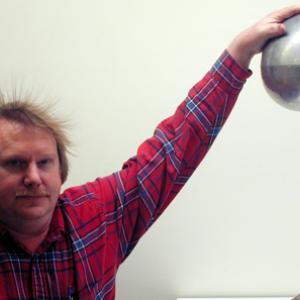College of Liberal Arts & Sciences
5B10.10 - Van de Graaff generator - Hair
Have the person stand on the milk crate and away from any metal objects. Have them put their hand on the Van de Graaff and turn it on. After a few seconds their hair should start to stand up and repel. Shaking the hair during this process helps.
Put fresh batteries into the Frankie Stein doll demo and press the large button in the front. There is a mini Van de Graaff in the demo that will charge her hair so that it stands out very well. If it is humid, you may have to charge and discharge her several times so that you can get a quicker reponse when you need to do the demo.
- Johanna Miller, "X rays peer inside a magnet", Physics Today, Vol. 70, September 2017, P. 17
- Carson I. A. Ritchie, "The Electrified Wig", Making Scientific Toys, p. 154.
- Borislaw Bilash II, David Maiullo, "Generating Electrostatic 'Phun'", A Demo a Day: A Year of Physics Demonstrations, p. 246.
- W. Bolton, "Electrostatic Charges and Hair", Book 4 - Electricity, Physics Experiments and Projects, 1968, p. 108.
- Rudolf F. Graf, "A Hair Raising Experiment", Safe and Simple Electrical Experiments, p. 31.
- Joseph Frick, "# 257 - Experiments with the Electrical Machine - Person on Insulating Stool", Physical Technics: Or Practical Instructions for Making Experiments in Physics and the Construction of Physical Apparatus with the Most Limmited Means, p. 281.
Disclaimer: These demonstrations are provided only for illustrative use by persons affiliated with The University of Iowa and only under the direction of a trained instructor or physicist. The University of Iowa is not responsible for demonstrations performed by those using their own equipment or who choose to use this reference material for their own purpose. The demonstrations included here are within the public domain and can be found in materials contained in libraries, bookstores, and through electronic sources. Performing all or any portion of any of these demonstrations, with or without revisions not depicted here entails inherent risks. These risks include, without limitation, bodily injury (and possibly death), including risks to health that may be temporary or permanent and that may exacerbate a pre-existing medical condition; and property loss or damage. Anyone performing any part of these demonstrations, even with revisions, knowingly and voluntarily assumes all risks associated with them.

